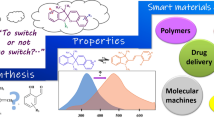Abstract
The photo-quenching mechanism of 2-(4-phenylboronic acid)-1-pyrenemethamide (C1-APB), which has potential application as a saccharide-recognition sensor, was investigated. By performing temperature-dependent time-resolved photoluminescence measurements, we determined the mechanism responsible for the photo-quenching properties of C1-APB to be a photoinduced electron transfer (PET). Moreover, the dependence of the electron transfer rate (kPET) on the solvent water concentration was explored in detail, and it was found that kPET increased by many orders of magnitude with increasing water concentrations. This phenomenon was analyzed using the Marcus model, in which the electron transfer can be represented by a potential diagram involving the potential barrier (ΔGa) and frequency factor (A). With the aid of temperature-dependent measurements, the contribution of ΔGa and A to the increase in kPET was successfully analyzed independently, which allowed us to discuss the effect of water molecule orientation and change in molecular structure of C1-APB. The temperature-dependence measurements performed in this study offer a powerful research tool for investigating the PET process, and will contribute to the development of molecular recognition fluorescent sensors.
Graphical abstract









Similar content being viewed by others
Data availability
PL decay curves at different water concentrations, obtained relaxation times and the temperature dependence of kPET are available in Supplemenary Information.
References
T.D. James, K.R.A.S. Sandanayake, S. Shinkai, Angew. Chem. Int. Ed. Engl. 1996, 35 (1910)
J.P. Lorand, J.O. Edwards, J. Org. Chem. 24, 769 (1959)
Z. Bian, A. Liu, Y. Li, G. Fang, Q. Yao, G. Zhang, Z. Wu, Analyst 145, 719 (2020)
T. Kubo, K. Kanemori, R. Kusumoto, T. Kawai, K. Sueyoshi, T. Naito, K. Otsuka, Anal. Chem. 87, 5068 (2015)
K. Sato, M. Takahashi, M. Ito, E. Abe, J. Anzai, J. Mater. Chem. B 3, 7796 (2015)
K. Sugita, Y. Tsuchido, C. Kasahara, M.A. Casulli, S. Fujiwara, T. Hashimoto, T. Hayashita, Front. Chem. 7, 806 (2019)
Y. Tsuchido, R. Sato, N. Nodomi, T. Hashimoto, K. Akiyoshi, T. Hayashita, Langmuir 32, 10761 (2016)
Y. Tsuchido, S. Fujiwara, T. Hashimoto, T. Hayashita, Chem. Pharm. Bull. 65, 318 (2017)
Y. Suzuki, A. Ikeda, K. Ohno, T. Fujihara, T. Sugaya, K. Ishihara, J. Org. Chem. 85, 9680 (2020)
X. Wu, X.-X. Chen, Y.-B. Jiang, Analyst 142, 1403 (2017)
X. Sun, T.D. James, Chem. Rev. 115, 8001 (2015)
Y. Tsuchido, R. Horiuchi, T. Hashimoto, K. Ishihara, N. Kanzawa, T. Hayashita, Anal. Chem. 91, 3929 (2019)
A. Mikagi, K. Manita, A. Yoyasu, Y. Tsuchido, N. Kanzawa, T. Hashimoto, T. Hayashita, Molecules 27, 256 (2022)
A.-J. Tong, A. Yamauchi, T. Hayashita, Z.-Y. Zhang, B.D. Smith, N. Teramae, Anal. Chem. 73, 1530 (2001)
A. Yamauchi, I. Suzuki, T. Hayashita, in Glucose Sensing, Topics in Fluorescence Spectroscopy, vol. 11, ed. by C.D. Geddes, J.R. Lakowicz (Springer, New York, 2006), p.237
Y. Tsuchido, S. Kojima, K. Sugita, S. Fujiwara, T. Hashimoto, T. Hayashita, Anal. Sci. 37, 721 (2021)
H. Kano, D. Tanoue, H. Shimaoka, K. Katano, T. Hashimoto, H. Kunugita, S. Nanbu, T. Hayashita, K. Ema, Anal. Sci. 30, 643 (2014)
C. Shimpuku, R. Ozawa, A. Sasaki, F. Sato, T. Hashimoto, A. Yamauchi, I. Suzuki, T. Hayashita, Chem. Commun. 2009, 1709 (2009)
T. Hashimoto, M. Kumai, M. Maeda, K. Miyoshi, Y. Tsuchido, S. Fujiwara, T. Hayashita, Front. Chem. Sci. Eng. 14, 53 (2020)
K. Sugita, Y. Suzuki, Y. Tsuchido, S. Fujiwara, T. Hashimoto, T. Hayashita, RSC Adv. 12, 20259 (2022)
H. Cao, T. McGill, M.D. Heagy, J. Org. Chem. 69, 2959 (2004)
W. Ni, G. Kaur, G. Springsteen, B. Wang, S. Franzen, Bioorg. Chem. 32, 571 (2004)
G. Kaur, N. Lin, H. Fang, B. Wang, in Glucose Sensing, Topics in Fluorescence Spectroscopy, vol. 11, ed. by C.D. Geddes, J.R. Lakowicz (Springer, New York, 2006), p.377
R.A. Marcus, J. Chem. Phys. 24, 966 (1956)
G.L. Closs, J.R. Miller, Science 240, 440 (1988)
P.F. Barbara, T.J. Meyer, M.A. Ratner, J. Phys. Chem. 100, 13148 (1996)
E.J. Piechota, G.J. Meyer, J. Chem. Educ. 96, 2450 (2019)
S. Fukuzumi, Electron Transfer: Mechanisms and Applications, 1st edn. (Wiley-VCH Verlag GmbH & Co. KGaA, Weinheim, 2020)
M. Tanaka, K. Ohkubo, C.P. Gros, R. Guilard, S. Fukuzumi, J. Am. Chem. Soc. 128, 14625 (2006)
L.F. Cotter, B.P. Rimgard, G.A. Parada, J.M. Mayer, L. Hammarstrom, J. Phys. Chem. A 125, 7670 (2021)
M. Kumai, S. Kozuka, M. Samizo, T. Hashimoto, I. Suzuki, T. Hayashita, Anal. Sci. 28, 121 (2012)
K. Hara, W.R. Ware, Chem. Phys. 51, 61 (1980)
D.S. Karpovich, G.J. Blanchard, J. Phys. Chem. 99, 3951 (1995)
Acknowledgements
We thank Ms. Mizuna Kawashima, Mr. Akito Suganuma, Mr. Riku Higa and Mr. Hiroya Kano for supporting our experiments. This work was supported by Sophia University Special Grant for Academic Research “Research in Priority Areas”.
Author information
Authors and Affiliations
Corresponding author
Supplementary Information
Below is the link to the electronic supplementary material.
Rights and permissions
Springer Nature or its licensor (e.g. a society or other partner) holds exclusive rights to this article under a publishing agreement with the author(s) or other rightsholder(s); author self-archiving of the accepted manuscript version of this article is solely governed by the terms of such publishing agreement and applicable law.
About this article
Cite this article
Yoshinaga, R., Kojima, F., Sugiyama, K. et al. Marcus model-based analysis of the photo-quenching mechanism of a boronic acid fluorophore: water concentration dependence of electron transfer rate. ANAL. SCI. 39, 213–220 (2023). https://doi.org/10.1007/s44211-022-00222-3
Received:
Accepted:
Published:
Issue Date:
DOI: https://doi.org/10.1007/s44211-022-00222-3




